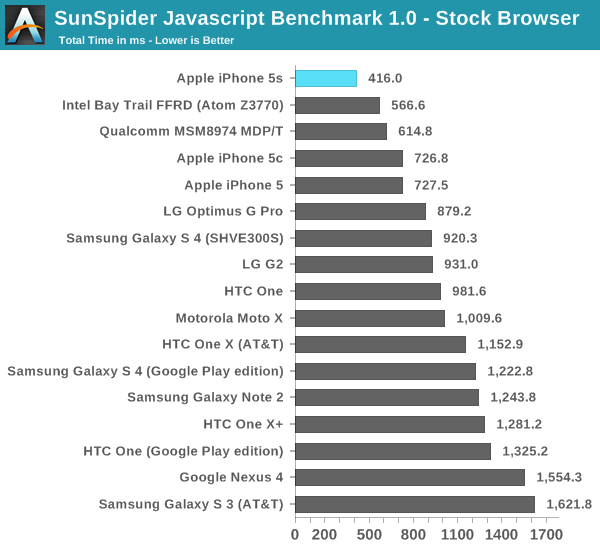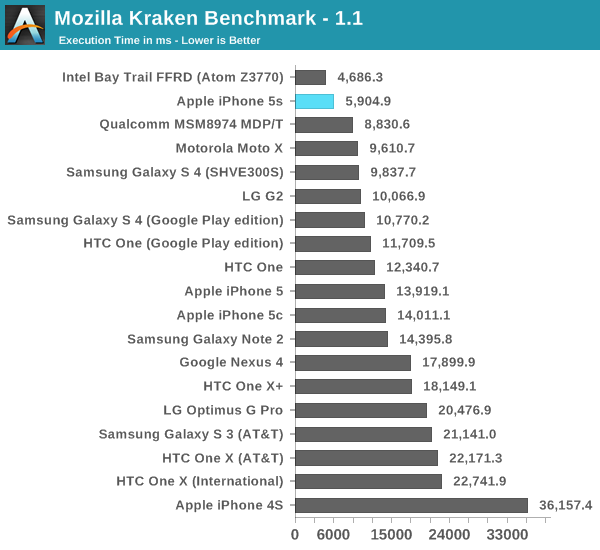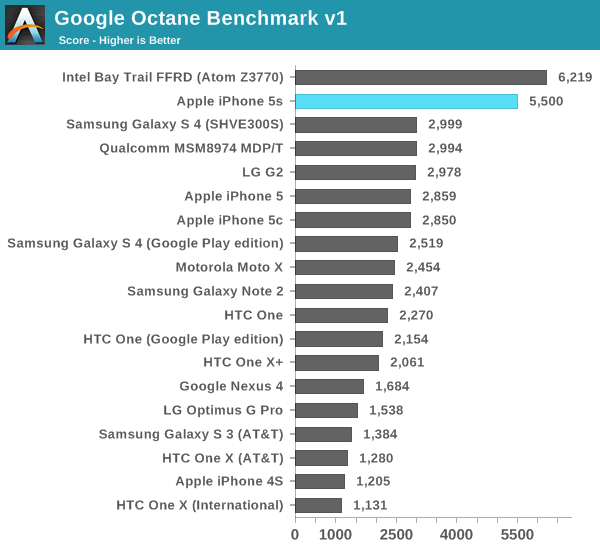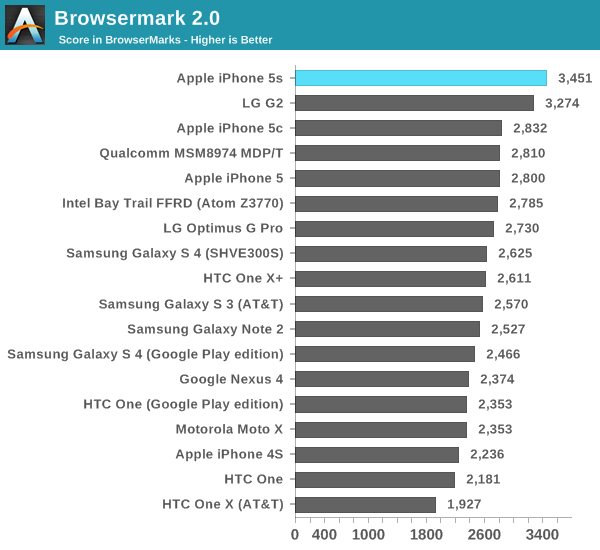The iPhone 5s Review
by Anand Lal Shimpi on September 17, 2013 9:01 PM EST- Posted in
- Smartphones
- Apple
- Mobile
- iPhone
- iPhone 5S
CPU Performance
For our cross-platform CPU performance tests we turn to the usual collection of Javascript and HTML5 based browser tests. Most of our comparison targets here are smartphones with two exceptions: Intel's Bay Trail FFRD and Qualcomm's MSM8974 Snapdragon 800 MDP/T. Both of those platforms are test tablets, leveraging higher TDP silicon in a tablet form factor. The gap between the TDP of Apple's A7 and those two SoCs isn't huge, but there is a gap. I only include those platforms as a reference point. As you're about to see, the work that Apple has put into the A7 makes the iPhone 5s performance competitive with both. In many cases the A7 delivers better performance than one or both of them. A truly competitive A7 here also gives an early indication of the baseline to expect from the next-generation iPad.
We start with SunSpider's latest iteration, measuring the performance of the browser's js engine as well as the underlying hardware. It's possible to get good performance gains by exploiting advantages in both hardware and software here. As of late SunSpider has turned into a bit of a serious optimization target for all browser and hardware vendors, but it can be a good measure of an improving memory subsystem assuming the software doesn't get in the way of the hardware.

Bay Trail's performance crown lasted all of a week, and even less than that if you count when we actually ran this benchmark. The dual-core A7 is now the fastest SoC we've tested under SunSpider, even outpacing Qualcomm's Snapdragon 800 and ARM's Cortex A15. Apple doesn't quite hit the 2x increase in CPU performance here, but it's very close at a 75% perf increase compared to the iPhone 5. Update: Intel responded with a Bay Trail run under IE11, which comes in at 329.6 ms.
Next up is Kraken, a heavier js benchmark designed to stress more forward looking algorithms. Once again we run the risk of the benchmark becoming an optimization target, but in the case of Kraken I haven't seen too much attention paid to it. I hope it continues to fly under the radar as I've liked it as a benchmark thus far.

The A7 falls second only to Intel's Atom Z3770. Although I haven't yet published these results, the 5s performs very similarly to an Atom Z3740 - a more modestly clocked Bay Trail SKU from Intel. Given the relatively low CPU frequency I'm not at all surprised that the A7 can't compete with the fastest Bay Trail but instead is better matched for a middle of the road SKU. Either way, A7's performance here is downright amazing. Once again there's a performance advantage over Snapdragon 800 and Cortex A15, both running at much higher peak frequencies (and likely higher power levels too, although that's speculation until we can tear down an S800 platform and a 5s to compare).
Compared to the iPhone 5, the 5s shows up at over 2.3x the speed of last year's flagship.
Next up is Google's Octane benchmark, yet another js test but this time really used as a design target for Google's own V8 js engine. Devices that can run Chrome tend to do the best here, potentially putting the 5s at a disadvantage.

Bay Trail takes the lead here once again, but again I expect the Z3740 to be a closer match for the A7 in the 5s at least (it remains to be seen how high the iPad 5 version of Cyclone will be clocked). The performance advantage over the iPhone 5 is a staggering 92%, and obviously there are big gains over all of the competing ARM based CPU architectures. Apple is benefitting slightly from Mobile Safari being a 64-bit binary, however I don't know if it's actually getting any benefit other than access to increased register space.
Our final browser test is arguably the most interesting. Rather than focusing on js code snippets, Browsermark 2.0 attempts to be a more holistic browser benchmark. The result is much less peaky performance and a better view at the sort of moderate gains you'd see in actual usage.

There's a fair amount of clustering around 2500 with very little differentiation between a lot of the devices. The unique standouts are the Snapdragon 800 based G2 from LG, and of course the iPhone 5s. Here we see the most modest example of the A7's performance superiority at roughly 25% better than the iPhone 5. Not to understate the performance of the iPhone 5s, but depending on workload you'll see a wide range of performance improvements.










464 Comments
View All Comments
solipsism - Wednesday, September 18, 2013 - link
I hadn't seen such a concise explanation of this tech. Thanks.Dug - Wednesday, September 18, 2013 - link
Very interesting and strange no one else has thought of doing this. I know using Nikon's system (CLS) exposure seems to be always right on, but depending on white balance setting it always needs adjustment.zshift - Tuesday, September 17, 2013 - link
Awesome review! A great read, as always.Dman23 - Tuesday, September 17, 2013 - link
Another awesome review by Anand Lal Shimpi! Informative and on point... love it.Crono - Tuesday, September 17, 2013 - link
I want to point out for the sake of consistency that Apple's naming convention is to use lowercase letters after the number for the iPhones. So it's "4s", not "4S", at least according to their website. It's annoying, I know, just pointing it out because it confused me at first so I looked it up.dylan522p - Tuesday, September 17, 2013 - link
Yeah, Brian went on a twitter rant of sorts about it. Pretty small but annoying change.tipoo - Tuesday, September 17, 2013 - link
Am I wrong, or is this the highest IPC smartphone core out there? 1.3 GHz, dual core, and it still doubles the performance of the A6 landing it into the territory most phones take higher clocked quads to get into.doobydoo - Wednesday, September 18, 2013 - link
Landing it way beyond all the current quad core phones.UpSpin - Wednesday, September 18, 2013 - link
Browserbenchmarks != CPU performanceSo it's possible that the good Browser benchmarks result more in a better optimized JS engine built for the A7? (because Samsung, NVidia, MS, ATI, Intel, ... all cheat in benchmarks, it's even possible that Apple still uses the not further optimized JS and Browser engine for the 5C, to increase the gap between A6 and A7 and make people believe the better browser scores are because of the A7, instead it's just heavy software optimization?)
Isn't it odd that a RAW CPU benchmark (3D Mark unlimited - Physics) positions the iPhone 5S on the same step as 5C and 5? (assuming there is no bug). 3D Mark also probably doesn't take advantage of 64-bit, but so will no near future App either, especially, because of the limited RAM, Games won't take 64-bit in the future either, else they'll blow the RAM limit more easily.
ScienceNOW - Tuesday, September 17, 2013 - link
F'ing thing sucks! I can all write it and we do it live! we do it live!